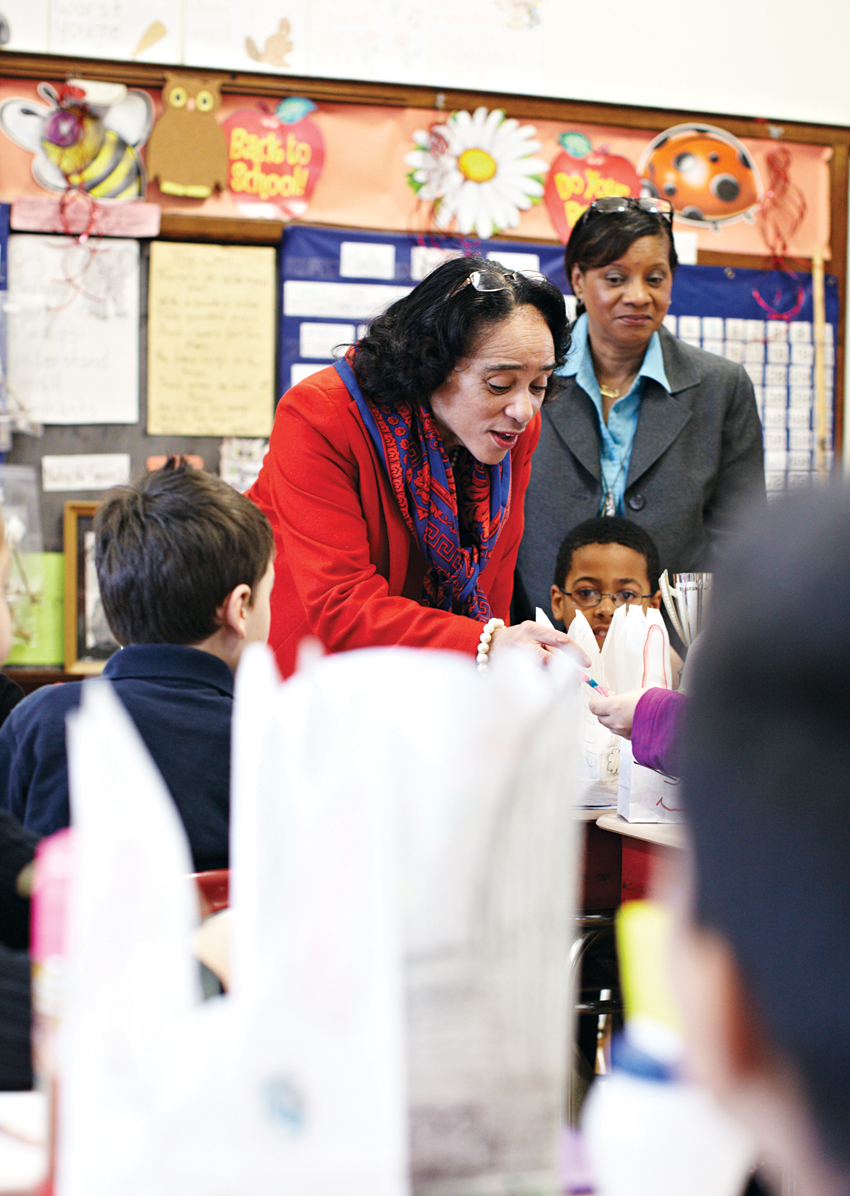Carol Johnson’s Boston Public

SCHOOLWORK. Johnson visiting with students this past April at the O’Donnell Elementary School, in East Boston. (Photo by Chris O’Donnell)
There have been times, naturally, when Menino’s political interests have shown. School-quality advocates speculate that Menino’s initial focus on boosting neighborhood schools through the new assignment process was an attempt to outflank John Connolly on the issue. Among mayoral politics watchers, Menino’s recent announcement that the city is buying a North End building for a new school was seen as a move to blunt Connolly’s criticism that the district has no strategic facilities plan—though it is also true that parents living in and around downtown have been agitating for several years for a new school. Connolly, for his part, accuses the mayor of “pulling the rug out” from under the schools in the two-year-long negotiations over a new teachers’ contract. Connolly is especially frustrated that the contract did not include the extended-day provisions Johnson had long insisted upon. Menino “didn’t push the envelope,” Connolly says. Johnson points out that the schools did get two out of the “three big things” they wanted in negotiations. The principals now have new flexibility in hiring and a more-robust teacher-evaluation process, which gives them more power in dealing with underperforming teachers.
The simple truth is this: In the years since Johnson took over, the schools have made measurable progress. The four-year graduation rate for BPS students is now 66 percent, the highest level ever recorded by BPS. Dropouts have fallen from a high of 9.4 percent in the 2006 to 2007 school year to around 6 percent in the 2010 to 2011 school year. Boston’s average eighth-grade math score on the National Assessment of Educational Progress in 2011 was well ahead of the big-city average and on par with the national average. MCAS scores have been going up. Arts and music are now at least a weekly event for 14,000 students. Summer-learning programs are thriving. There are still 48 Level 3 schools in Boston, but that’s down from 68 a few years ago. A series of strong principals have taken schools that were once at the bottom of the heap and propelled them forward, while others have turned schools that were doing okay into ones with long waiting lists. Enrollment next year will be the highest it’s been in eight years.
There is no question that the district has a ways to travel. “I talk about the dentist,” says Carleton Jones, BPS’s facilities chief, who led the technical-support team for the school-assignment remake. “I don’t want to have a dentist who’s ‘getting better.’ I want a dentist who’s proficient.”
Getting there requires progress on a bewildering array of fronts, and that progress has already begun. Johnson and Menino are pursuing legislation that would build on the 2010 law that gave BPS the right to create its own charter schools. This time, they hope to give school administrators throughout the system greater flexibility on hiring and firing, curriculum, and work rules. Johnson has also been a steadfast advocate not only of creating a “portfolio” of schools with the freedom to pursue educational innovation, but also of working with state-chartered schools. “The thing that Carol gets,” Paul Grogan says, “is that without the external pressure from charters, you can’t change the system.” Johnson has also taken a few small but crucial steps that show up directly in classrooms, such as adding literacy coaches and teacher training to focus on reading in the early grades, championing arts education, and pressing non-exam middle schools and K–8s to make sure eighth-grade students get to study algebra.
Some of Johnson’s longest-lasting contributions will come from several under-the-radar changes she has steered through. The farthest-reaching is “weighted student funding,” a budgeting reform designed by John McDonough and his former deputy, Seth Racine. Schools no longer get money based on their programming. Instead, their budgets depend on how many and what kinds of students they have. Schools with a greater number of English-language learners, special-ed students, and kids from poor families get more. They have an incentive, in other words, to recruit the students who need the most help, rather than shunning them. The entire system, McDonough says, is also more focused on how to attract and serve students in an era of stiff competition from charters. “We went from just the mayor and superintendent being concerned about our competitive advantage,” he says, “to 128 school leaders who now need to fight for every student in the city.”
Similarly, BPS has put great effort into making data on every child available to every school administrator and every teacher. Schools can now start delving into the numbers to see where individual students need academic help. And the district can better understand which factors—a school’s culture of teacher collaboration, more time well-used in the school day, summer school, support for kids with difficult home lives, the rigorous tracking of each child—move the needle for everyone.
As she prepares to leave Boston, Johnson has no plans to seek another school system to oversee. “There are so many things you can do other than being superintendent to help kids learn,” she says. “I’m sure there will be other ways for me to serve.”
But that probably won’t stop other cities from knocking on her door. “She is enormously popular personally,” Michael Casserly says, “and profoundly respected for her experience, her academic expertise, her thoughtfulness and sense of strategy, and her ability to work well with others.” When other cities look at where Boston’s schools are now, he adds, they like what they see. “It’s something Boston probably doesn’t know, in the midst of all the little day-to-day fights it has. But the truth is that any city in the country would love to have her.”

